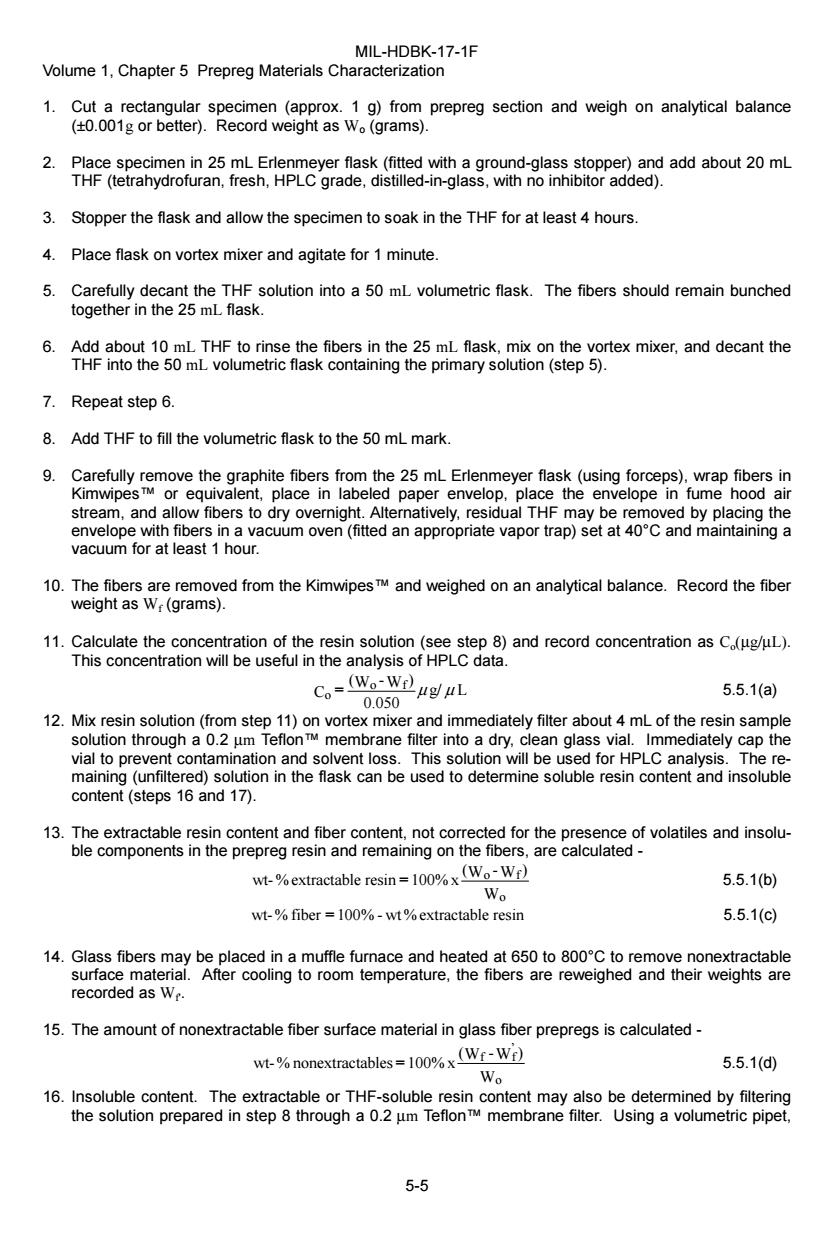正在加载图片...

MIL-HDBK-17-1F Volume 1,Chapter 5 Prepreg Materials Characterization 1.Cut a rectangular specimen (approx.1 g)from prepreg section and weigh on analytical balance (+0.001g or better).Record weight as Wo(grams). 2.Place specimen in 25 mL Erlenmeyer flask(fitted with a ground-glass stopper)and add about 20 mL THF(tetrahydrofuran,fresh,HPLC grade,distilled-in-glass,with no inhibitor added). 3.Stopper the flask and allow the specimen to soak in the THF for at least 4 hours. 4.Place flask on vortex mixer and agitate for 1 minute. 5.Carefully decant the THF solution into a 50 mL volumetric flask.The fibers should remain bunched together in the 25 mL flask. 6.Add about 10 mL THF to rinse the fibers in the 25 mL flask,mix on the vortex mixer,and decant the THF into the 50 mL volumetric flask containing the primary solution(step 5). 7.Repeat step 6. 8.Add THF to fill the volumetric flask to the 50 mL mark. 9.Carefully remove the graphite fibers from the 25 mL Erlenmeyer flask(using forceps).wrap fibers in KimwipesTM or equivalent,place in labeled paper envelop,place the envelope in fume hood air stream,and allow fibers to dry overnight.Alternatively,residual THF may be removed by placing the envelope with fibers in a vacuum oven(fitted an appropriate vapor trap)set at 40C and maintaining a vacuum for at least 1 hour. 10.The fibers are removed from the Kimwipes TM and weighed on an analytical balance.Record the fiber weight as Wr(grams). 11.Calculate the concentration of the resin solution(see step 8)and record concentration as Co(ug/uL). This concentration will be useful in the analysis of HPLC data. C。=Wo-WuL 5.5.1(a) 0.050 12.Mix resin solution(from step 11)on vortex mixer and immediately filter about 4 mL of the resin sample solution through a 0.2 um Teflon TM membrane filter into a dry,clean glass vial.Immediately cap the vial to prevent contamination and solvent loss.This solution will be used for HPLC analysis.The re- maining(unfiltered)solution in the flask can be used to determine soluble resin content and insoluble content(steps 16 and 17). 13.The extractable resin content and fiber content,not corrected for the presence of volatiles and insolu- ble components in the prepreg resin and remaining on the fibers,are calculated- wt-%extractable resin=100%xWo-Wr 5.5.1(b) Wo wt-%fiber =100%-wt%extractable resin 5.5.1(c 14.Glass fibers may be placed in a muffle furnace and heated at 650 to 800C to remove nonextractable surface material.After cooling to room temperature,the fibers are reweighed and their weights are recorded as W. 15.The amount of nonextractable fiber surface material in glass fiber prepregs is calculated- wt-%nonextractables=100%xWr-Wr) 5.5.1(d) W。 16.Insoluble content.The extractable or THF-soluble resin content may also be determined by filtering the solution prepared in step 8 through a 0.2 um Teflon TM membrane filter.Using a volumetric pipet, 5-5MIL-HDBK-17-1F Volume 1, Chapter 5 Prepreg Materials Characterization 5-5 1. Cut a rectangular specimen (approx. 1 g) from prepreg section and weigh on analytical balance (±0.001g or better). Record weight as Wo (grams). 2. Place specimen in 25 mL Erlenmeyer flask (fitted with a ground-glass stopper) and add about 20 mL THF (tetrahydrofuran, fresh, HPLC grade, distilled-in-glass, with no inhibitor added). 3. Stopper the flask and allow the specimen to soak in the THF for at least 4 hours. 4. Place flask on vortex mixer and agitate for 1 minute. 5. Carefully decant the THF solution into a 50 mL volumetric flask. The fibers should remain bunched together in the 25 mL flask. 6. Add about 10 mL THF to rinse the fibers in the 25 mL flask, mix on the vortex mixer, and decant the THF into the 50 mL volumetric flask containing the primary solution (step 5). 7. Repeat step 6. 8. Add THF to fill the volumetric flask to the 50 mL mark. 9. Carefully remove the graphite fibers from the 25 mL Erlenmeyer flask (using forceps), wrap fibers in Kimwipes™ or equivalent, place in labeled paper envelop, place the envelope in fume hood air stream, and allow fibers to dry overnight. Alternatively, residual THF may be removed by placing the envelope with fibers in a vacuum oven (fitted an appropriate vapor trap) set at 40°C and maintaining a vacuum for at least 1 hour. 10. The fibers are removed from the Kimwipes™ and weighed on an analytical balance. Record the fiber weight as Wf (grams). 11. Calculate the concentration of the resin solution (see step 8) and record concentration as Co(µg/µL). This concentration will be useful in the analysis of HPLC data. o o f C = (W -W ) 0.050 µ µ g/ L 5.5.1(a) 12. Mix resin solution (from step 11) on vortex mixer and immediately filter about 4 mL of the resin sample solution through a 0.2 µm Teflon™ membrane filter into a dry, clean glass vial. Immediately cap the vial to prevent contamination and solvent loss. This solution will be used for HPLC analysis. The remaining (unfiltered) solution in the flask can be used to determine soluble resin content and insoluble content (steps 16 and 17). 13. The extractable resin content and fiber content, not corrected for the presence of volatiles and insoluble components in the prepreg resin and remaining on the fibers, are calculated - wt- % extractable resin = 100% x (W -W ) W o f o 5.5.1(b) wt- % fiber = 100% - wt % extractable resin 5.5.1(c) 14. Glass fibers may be placed in a muffle furnace and heated at 650 to 800°C to remove nonextractable surface material. After cooling to room temperature, the fibers are reweighed and their weights are recorded as Wf' . 15. The amount of nonextractable fiber surface material in glass fiber prepregs is calculated - wt- % nonextractables = 100% x (W -W ) W f f’ o 5.5.1(d) 16. Insoluble content. The extractable or THF-soluble resin content may also be determined by filtering the solution prepared in step 8 through a 0.2 µm Teflon™ membrane filter. Using a volumetric pipet